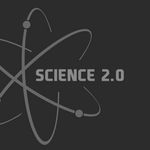Optics

Using ESO's Very Large Telescope, an international team of astronomers [1] has discovered a stunning rare case of a triple merger of galaxies. This system, which astronomers have dubbed 'The Bird' - albeit it also bears resemblance with a cosmic Tinker Bell - is composed of two massive spiral galaxies and a third irregular galaxy.
The galaxy ESO 593-IG 008, or IRAS 19115-2124, was previously merely known as an interacting pair of galaxies at a distance of 650 million light-years. But surprises were revealed by observations made with the NACO instrument attached to ESO's VLT, which peered…

As a step towards designing tomorrow's super-fast optical communications networks, a Duke University-led research team has demonstrated a way to transfer encoded information from a laser beam to sound waves and then back to light waves again.
Swapping data between media like this would allow information to be captured and retained for very brief intervals. Data could be stored within pockets of acoustic vibration created when laser beams interact along a short strand of optical fiber, the team reported in Science.
The Duke experiments address a barrier to efforts at developing computer…

A Princeton-led research team has created an easy-to-produce material from the stuff of computer chips that has the rare ability to bend light in the opposite direction from all naturally occurring materials. This startling property may contribute to significant advances in many areas, including high-speed communications, medical diagnostics and detection of terrorist threats.
A Princeton-led research team has created an easy-to-produce material from the stuff of computer chips that has the rare ability to bend light in the opposite direction from all naturally occurring materials. This…

A tiny galaxy,SDSSJ0737+3216 (lens redshift 0.3223, source redshift 0.5812), nearly halfway across the universe and the smallest in size and mass known to exist at that distance, has been identified by an international team of scientists.
The scientists used data collected by NASA's Hubble Space Telescope and the W. M. Keck Observatory in Hawaii. This galaxy is about half the size, and approximately one-tenth the "weight" of the smallest distant galaxies typically observed, and it is 100 times lighter than our own Milky Way.
"Even though this galaxy is more than six billion light years away,…

A plant-like micro-organism mostly found in oceans could make the manufacture of products, from iridescent cosmetics, paints and fabrics to credit card holograms, cheaper and ‘greener’.
The tiny single-celled ‘diatom’, which first evolved hundreds of millions of years ago, has a hard silica shell which is iridescent – in other words, the shell displays vivid colours that change depending on the angle at which it is observed. This effect is caused by a complex network of tiny holes in the shell which interfere with light waves.
Diatoms are classified as eukaryotic algae and represent one of…

The brand-new Large Binocular Telescope (LBT) in Arizona has a gotten off to an astronomical start, helping an international team of astronomers learn that a recently discovered tiny companion galaxy to our Milky Way, named the Hercules Dwarf Galaxy, has truly exceptional properties: unlike the round tiny dwarf galaxies found so far, this neighbor 430,000 light years away is shaped more like a cigar.
The stars in many large galaxies are arranged in a disk-like configuration, like our Milky Way, but among the millions of well-studied tiny dwarf galaxies none has ever been observed to have a…
In an experiment modeled on the classic “Young’s double slit experiment” and published in the journal Nature Nanotechnology, researchers have powerfully reinforced the understanding that surface plasmon polaritons (SPPs) move as waves and follow analogous rules.
The demonstration reminds researchers and electronics designers that although SPPs move along a metal surface, rather than inside a wire or an optical fiber, they cannot magically overcome the size limitations of conventional optics.
Touted as the next wave of electronics miniaturization, plasmonics describes the movement of SPPs…
Like crowds of people, microscopic particles can act together under the right conditions. By exposing crowd behavior at the atomic scale, scientists discover new states and properties of matter. Now, ultrafast lasers have revealed a previously unseen type of collective electronic behavior in semiconductors, which may help in the design of optoelectronic devices.
Design of optoelectronic devices, like the semiconductor diode lasers used in telecommunications, currently involves a lot of trial and error. A designer trying to use basic theory to calculate the characteristics of a new diode…

Like the surface motif of a bubble bath, the spatial distribution of a magnetic field penetrating a superconductor can exhibit an intricate, foam-like structure. Ruslan Prozorov at the U.S. Department of Energy’s Ames Laboratory has observed these mystifying, two-dimensional equilibrium patterns in lead samples when the material is in its superconducting state, below 7.2 Kelvin, or minus 446.71 degrees Fahrenheit.
Through innovative research to relate the complex geometry of the equilibrium patterns to the macroscopic physical properties, such as magnetism, Prozorov has shown that the shape…

New research led by University of New Hampshire physicists has proved the existence of a new type of electron wave on metal surfaces: the acoustic surface plasmon, which will have implications for developments in nano-optics, high-temperature superconductors, and the fundamental understanding of chemical reactions on surfaces. The research, led by Bogdan Diaconescu and Karsten Pohl of UNH, is published in the July 5 issue of the journal “Nature.”
“The existence of this wave means that the electrons on the surfaces of copper, iron, beryllium and other metals behave like water on a lake’s…